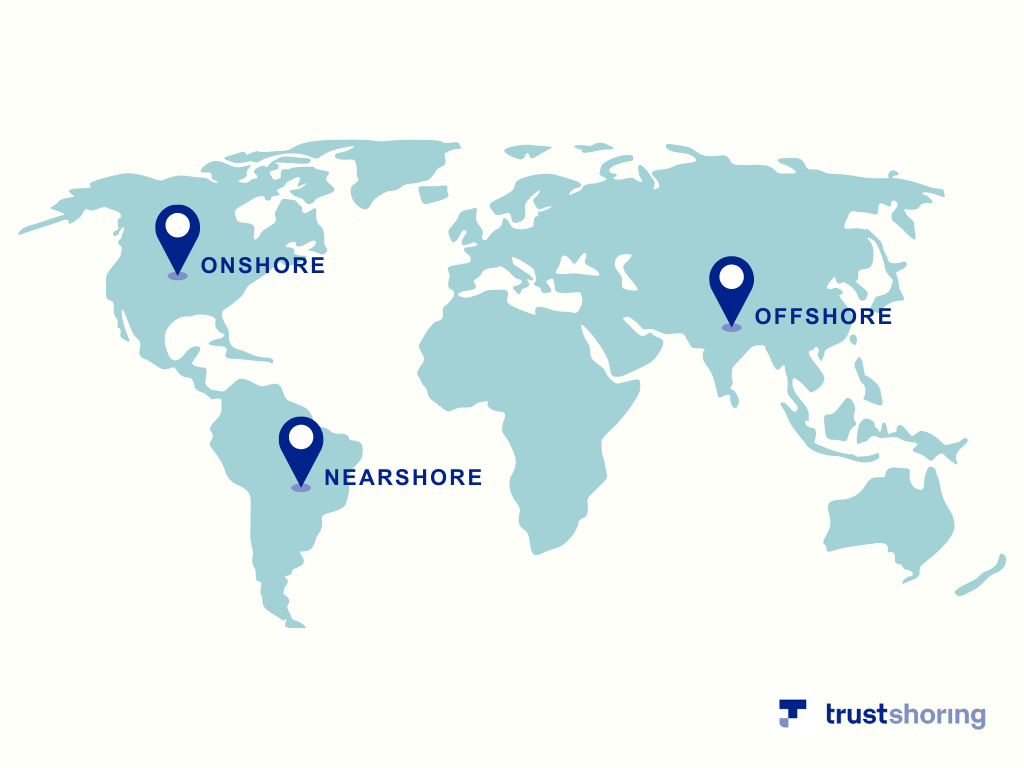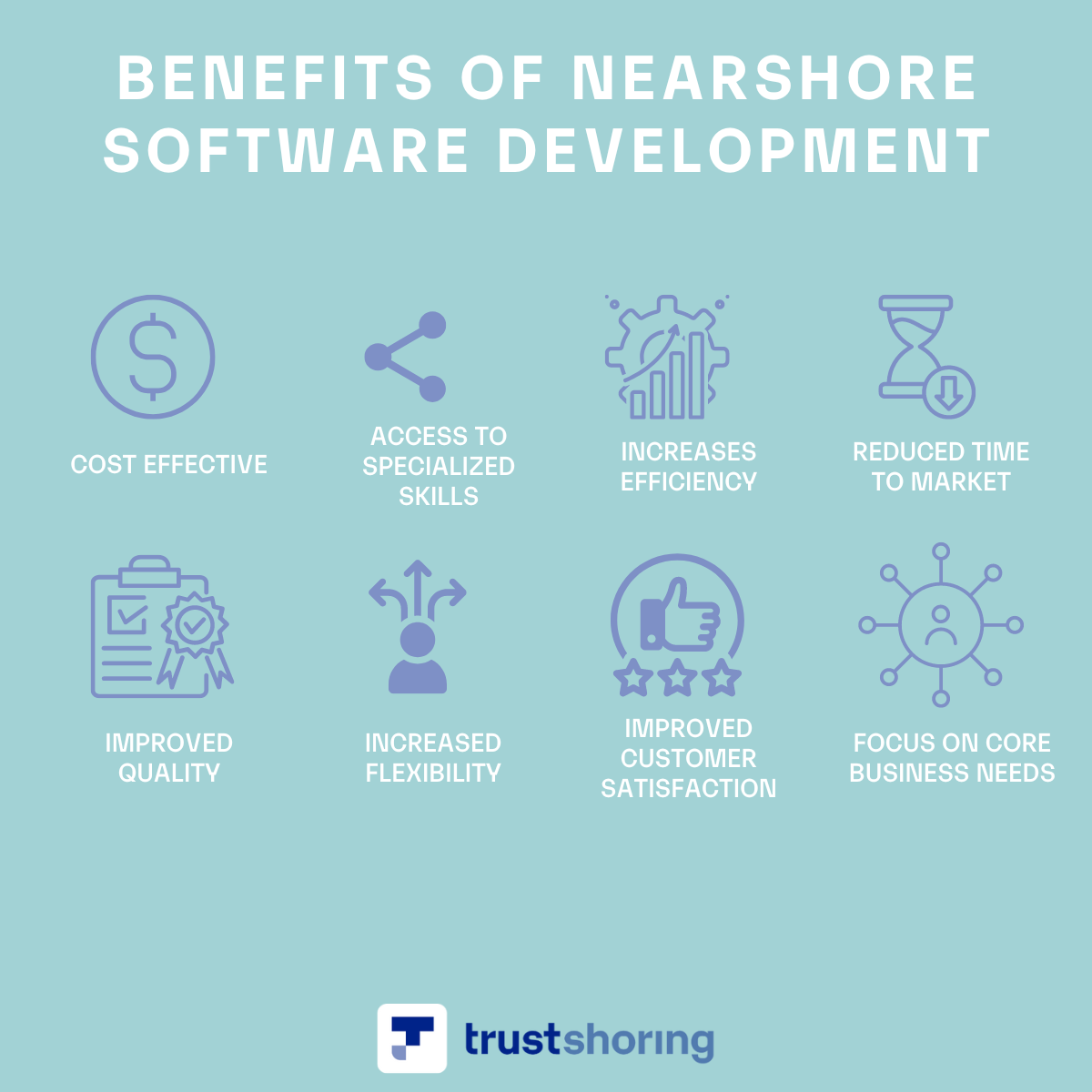Blog
Ultimate Guide to Nearshore Software Development

Introduction
For any business to grow, it must develop more efficient systems, in terms of both costs and operations. Each action performed and dollar spent needs to produce more results and generate more revenue—and one way this can become possible is by nearshoring software development. This article will cover the basics of Nearshore software development, the difference between nearshore software developers and offshore software development, and what nearshoring means for businesses.
Nearshore software development is a way to outsource tasks related to programming, designing, and maintaining software.
By outsourcing these tasks, businesses can reap the benefits of custom software and ensure that the best quality software is delivered quickly. This helps businesses to get their software to market faster, improving their time-to-market.
What is Nearshore Software Development
Nearshore software development is when a company has distributed teams in countries that are in the same or similar time zone. Fortunately, with the help of modern remote team management tools and video conferencing software, working with providers from anywhere in the world is now a breeze.
Build a simple product that works and converts.
Get step-by-step guidance from product managers, UI/UX designers, and tech leads, taking you from idea to launch
Creating a new digital product from scratch is a complex process. Success requires a lot of planning, management, and technical knowledge.
Nearshore software development companies can simplify this process by providing experienced teams and resources to help bring the product to life. They can assist with deadlines, manage the technical aspects of the project, and more. This can make the process of launching the product smoother and more efficient.
Nearshore software outsourcing is an effective way to access skilled developers in another country, allowing businesses to take advantage of lower costs and diverse skill sets.
It involves outsourcing software development from a remote location and utilizing the services of a team located in a different country to create applications for use in the home country. This can offer a variety of advantages, from cost savings to access to a wider range of skill sets.
The difference between Nearshore and Offshore software development
Offshore software development means that your development partner is in another country with a different time zone, while nearshore companies are located within the same time zone, usually in a neighboring country.

For example, a US company that outsources to the Mexican team stands for nearshore software development and a Canadian company that gets its software development services from the Ukrainian vendor is offshore software development.
Top 3 latest trends in nearshore software development
The rise of nearshore software development has seen a shift toward companies embracing the latest trends to remain competitive. Businesses can create innovative products and services faster and more efficiently by taking advantage of the latest technology, tools, and techniques.
This is why nearshore software companies must stay abreast of the changing trends to remain ahead of the competition and develop robust, efficient software solutions. Businesses across the world are already adapting and adopting these new technologies, and those who do not adapt quickly enough may get left behind. Here are three of the latest trends in nearshore software development:
1. Artificial Intelligence & Machine Learning
AI and ML are becoming increasingly popular in the field of nearshore software development. The rise of the much-talked-about ChatGPT has raised awareness of the potential and ability of machine learning and artificial intelligence.
By leveraging machine learning, natural language processing, and business rules, developers can quickly create more reliable, higher-quality software. AI can improve the efficiency of code testing and enhance the overall quality of the software created by nearshore teams.
2. Microservices & Serverless
Microservices architecture has emerged as a popular approach for developing software applications in recent years. Instead of building monolithic applications, microservices architecture involves breaking down an application into smaller, independent services that can be developed, deployed, and scaled independently.
This approach offers several benefits, including increased flexibility, better scalability, and improved fault tolerance.
Serverless is a model in which application code is executed on-demand in response to triggers that application developers configure ahead of time. The main benefit of serverless is that it offers an efficient way to execute code that doesn’t need to run continuously.
Without serverless, you’d have to keep all parts of your application running constantly, which would waste resources. Serverless functions allow you to configure certain parts of your application to run only when they’re needed.
3. Low-code
No-code or low-code software development is a type of web development that allows non-programmers and programmers to create software using a graphical user interface, instead of writing code. The no-code movement rests upon the fundamental belief that technology should enable and facilitate the creation, not be a barrier to entry.
Where app development and launching web applications was once only possible by skilled programmers, no-code development platforms, along with the wealth of tutorials out there can get anyone on their way to getting their ideas out there. Being a non-programmer no longer matters.
No-code is simply an abstraction layer over code. Meaning, it takes the fundamentals of code and translates them into simple drag-and-drop solutions — allowing creators to build modern apps and websites visually.
Any layer of abstraction and simplification comes with a loss of flexibility, though, so there are limitations to where LowCode and NoCode tools can be usefully used.
Other Future Trends in Nearshore Software Development
1. Internet of Things (IoT)
The Internet of Things (IoT) is a term used to describe the network of interconnected physical devices, vehicles, buildings, and other objects that are embedded with sensors, software, and network connectivity.
These embedded systems enable the devices to collect, exchange, and analyze data, allowing them to communicate with one another and with centralized systems over the Internet.
The Internet of Things (IoT) is rapidly becoming a significant factor in nearshore software development. IoT devices and applications require specialized expertise in hardware and software integration, data management, and security.
Nearshore software development companies are increasingly working on IoT projects, developing applications for industries such as healthcare, agriculture, and smart cities. As IoT devices and applications become more prevalent, nearshore developers will need to adapt and expand their skill sets to meet the growing demand for IoT solutions.
2. Industry 4.0
Industry 4.0: Also known as the Fourth Industrial Revolution, Industry 4.0 is characterized by the integration of digital technologies, such as the Internet of Things (IoT), artificial intelligence (AI), and automation, into the manufacturing and production processes. In the context of nearshore software development, companies will increasingly adopt Industry 4.0 technologies to streamline operations, improve efficiency, and create innovative solutions for various industries.
3. Logistics
As supply chains become more complex and globalized, nearshore software development companies will play a pivotal role in the advancement of logistics technology. They will develop solutions for tracking shipments, optimizing routes, managing inventory, and automating various aspects of the supply chain. By leveraging nearshore talent, companies can access specialized skills and expertise to stay competitive in the rapidly evolving logistics sector.
4. Software as a Service (SaaS)
The SaaS model has revolutionized the way businesses consume software, allowing them to access applications over the Internet without the need for in-house infrastructure. Nearshore software development companies are expected to focus on creating SaaS solutions for a diverse range of industries, catering to the growing demand for cost-effective, scalable, and easy-to-use software. As the SaaS market continues to expand, nearshore developers will play a crucial role in helping businesses transition to cloud-based solutions.
5. Marketplaces
The rise of digital marketplaces has disrupted traditional business models, enabling buyers and sellers to connect seamlessly through online platforms. Nearshore software development companies will be at the forefront of creating and maintaining these marketplaces, ensuring smooth user experiences and secure transactions. As more industries embrace digital marketplaces, nearshore developers will have ample opportunities to contribute their expertise and help shape the future of e-commerce and online service provision.
6. Emerging & Expanding Nearshore Destinations
As the demand for nearshore software development services continues to grow, new regions are emerging as attractive destinations for nearshoring.
Countries in Eastern Europe, Southeast Asia, and Latin America have gained popularity due to several factors such as cost competitiveness, growing talent pools, and time zone advantages.
Benefits of nearshore software development

More or less, every company can benefit from outsourcing development. After all, the approach comes with time-tested benefits like:
1. Cost-effective
Nearshore software development is cost-effective because businesses can access a wide range of skilled professionals at lower costs than they would pay for in-house software development. This cost advantage is especially beneficial for smaller companies that cannot afford to hire a full-time software development team.
The cost savings associated with the outsourcing model of nearshore software development come from the lower labor costs in countries where the development team is located. In addition, nearshore companies often provide additional services such as project management, testing, and quality assurance, which can further reduce the overall cost of development.
2. Access to specialized skills
Nearshore software development offers access to a wide range of specialized skills that may not be available in-house. This includes access to a global talent pool and access to the latest technology and software development tools.
By leveraging the skills of a specialized nearshore development outsourcing team, companies can save time and money by quickly and efficiently creating high-quality software solutions.
3. Increases efficiency
Nearshore software development can significantly increase the efficiency of the development process. This can help to reduce the time it takes to develop a project and can also help to reduce the number of errors that can occur during the development process.
4. Reduced time to market
Nearshore software development can significantly reduce the time it takes to take a product to market. By outsourcing development projects, a company can benefit from rapid project completion by taking advantage of the resources available in the nearshore development center. This allows the company to reduce development costs, as well as speed up the time to market.
For instance, a company may be able to develop a prototype in a matter of weeks or months, rather than the typical months or years it would take for a similar project to be completed in-house.
Additionally, nearshore software development allows companies to leverage the expertise of experienced developers from around the world, enabling them to benefit from faster project completion and shorter development cycles.
5. Improved quality
Nearshore outsourcing of software development can also provide improved quality. By outsourcing development, companies can benefit from access to a larger pool of talent, including experienced developers worldwide.
This allows the company to take advantage of the best practices employed by these developers, as well as their expertise in the specific technologies used for the project.
Additionally, the cost savings associated with nearshore software development can be used to invest in quality assurance measures, such as testing and bug fixing. This can help ensure that the final product is of the highest possible quality and that the end users have a positive experience.
6. Increased flexibility
Nearshore software development provides companies with increased flexibility in their development process. This means that companies can quickly adjust their development process to quickly accommodate changing customer needs and requirements.
The ability to quickly adjust to customer needs allows companies to stay ahead of the competition and provide customers with better services.
Additionally, with nearshore software development, companies have access to a larger pool of developers, allowing them to easily find the right developer for their project. This provides companies with the ability to quickly scale up or scale down their development efforts as needed.
7. Improved customer satisfaction
Nearshore software development also provides companies with improved customer satisfaction. By outsourcing development, companies can quickly deliver high-quality software products to their customers.
This ensures that customers have access to the latest features and technology and that their software needs are met in a timely and efficient manner. Additionally, nearshore software development teams provide companies with a higher level of customer service.
These teams can quickly respond to customer inquiries and provide feedback on their software development progress. This allows companies to build strong relationships with their customers, as they can provide them with timely and effective customer service.
8. Focus on core business needs
Nearshore software development permits businesses to concentrate on their primary objectives instead of dealing with the intricate and lengthy process of developing software. This allows companies to concentrate on their most important aspects without devoting resources to managing a software development team.
Challenges associated with nearshore software development
1. Communication challenges
One of the biggest challenges associated with nearshore software development is communication. With developers working in different countries, it can be difficult to coordinate meetings and ensure that everyone is on the same page.
Additionally, cultural differences and language barriers can make it difficult for developers to effectively communicate with each other, as well as with the customer.
This can lead to misunderstandings and delays in the development process. To help overcome this challenge, companies should make sure that their offshore development team is well-versed in the customer’s language and culture, and that they have a clear understanding of the customer’s requirements and expectations.
At Trustshoring, we aim to transfer as much context about the business, its clients, goals, and challenges as possible, aside from just the requirements from a specific project
2. Quality control
Another challenge associated with the nearshore software development model is quality control. Since developers are working in different locations, it can be difficult to ensure that the code is being written correctly and that the software meets the customer’s requirements.
Additionally, it can be hard to ensure that the developers are following the same coding standards and best practices.
To help overcome this challenge, companies should set up quality control processes and ensure that the developers are following them. This can include regular testing of the code, as well as having an experienced developer review the code before it is released.
- Within Trustshoring’s teams, developers adhere to clear coding standards
- Code reviews and tests according to industry standards and best practices
- Mature processes
3. Security concerns
Security is another major challenge associated with nearshore software development. Since the development team is located in a different country, sometimes it can be difficult to ensure that the customer’s data is secure. Additionally, there is always the risk of data being stolen or leaked.
To help mitigate this risk, companies should make sure that the nearshore development team is following security best practices. This can include using secure coding standards, encrypting data, and setting up access control measures.
- For added security, one might not give access to production data
- Sign data protection agreements and addendums
- Choose a partner who takes security seriously
- Make sure to sign NDAs and IP transfer clauses to protect your intellectual property
4. Cost management
One of the main challenges associated with a nearshore software development team is cost management. Companies must ensure that they can manage their costs effectively to maximize their return on investment. This is especially true if the offshore team is located in a different country with a different currency.
Companies must ensure that they can accurately budget for their nearshore software development project and that they can accurately track and monitor their costs. Additionally, companies must also ensure that they can accurately predict the costs associated with future development projects to effectively manage their costs.
- Estimates in hours or points
- Fixed-price contracts for certain types of projects like MVPs
- At Trustshoring, we offer fixed-price bids for certain projects and take risks in projects an active discussion to understand how they can be mitigated
Best practices of nearshore software development
If you’re looking to offshore some of your software development, then here are some best practices to help you reach your goals:
1. Build small, skilled teams
Create teams with a limited number of highly skilled individuals capable of collaborating well together.
🎙️ Podcast
Secrets from 15 years of managing remote-first engineering teams with Hannes Kleist, from Stanwood
This will allow for better visibility and communication between team members, leading to more positive results.
2. Consider an onshore product manager
Another great option is considering having an onshore product manager. It’s not a must, but it can be a massive help in ensuring that business objectives are communicated and met.
He or she doesn’t have to be very technical, they just need to have actionable insights into the day-to-day activities of the business and understand the clients and processes. They can then devote their time to making product decisions and interfacing with the development team.
3. Use the right software development tracking tools
Developing software can be an arduous process. To ensure that your project is completed on time and to the highest quality, it is important to have the right tools to track and manage the project.
Utilizing software development tracking tools will help you break down tasks, assign them to team members, and prioritize work to ensure that your software is delivered on time and meets the needs of your business.
- JIRA is industry-standard, but many other tools work just as well.
- At Trustshoring, most teams use JIRA and give the client full access to the boards, tasks, comments, and progress as well as invite the client to collaborate on descriptions and voice their opinion in the comments.
4. Arrange daily meetings and meet up regularly in person
Set up regular video calls with the onshore and nearshore teams to discuss the project’s progress and address any issues that arise. Doing this will help ensure that all team members are communicating regularly and that any problems are addressed promptly and effectively.
Another great option is to visit the nearshore team when you can, this helps build a great relationship with them and even allows you to get a sense of how the team works.
At Trustshoring, we encourage clients to get together with their teams for larger planning sessions to transfer critical business knowledge, brainstorm solutions, and get to know each other better.
How to choose the right nearshore software development partner
The importance of choosing the right team to outsource to cannot be overstated. One of the primary benefits of partnering with the right nearshore development company is the ability to collaborate more effectively.
With similar time zones, communication and coordination between your in-house team and the outsourced team become much more manageable, enabling real-time updates, faster issue resolution, and increased productivity.
On the flip side, selecting the wrong nearshore development partner can lead to several challenges and setbacks for your business. An inexperienced or low-quality development company may struggle to deliver projects on time or produce subpar work, ultimately affecting your business’s bottom line.
Furthermore, issues related to intellectual property protection, data security, and legal compliance may arise if your nearshore partner does not adhere to strict standards and best practices. Therefore, it’s crucial to carefully assess potential partners’ expertise, experience, and reputation before making a decision.
To ensure a fruitful partnership, conduct thorough research and carefully evaluate the experience, capabilities, and values of potential nearshore development partners. This can be done by having a look at the company’s client list, reviews on sites like Clutch, and even having a look at the company’s case study section on its website.
What You Need to Make Nearshore Software Development Succeed
Nearshore software development is a very beneficial approach for software development companies.
By outsourcing a portion of the project to an expert team, firms can save time and money while achieving the desired results. Additionally, having a nearshore software development team allows businesses to focus on other, more pressing matters. Several elements are crucial to the success of nearshore software outsourcing for companies, These include:
1. The right strategy
A comprehensive plan of action is essential for any project manager or company to succeed, with everyone taking on their duties to complete the task. This creates a better understanding of the whole process.
An effective strategy also ensures that each team member is assigned the right role at the right time and that the necessary strategies are implemented at the appropriate stages.
2. A talented team
For successful offshore outsourcing, it’s critical to have a team of highly qualified and experienced professionals. Specialized knowledge and up-to-date technology are essential for any project to be successful. A proficient offshore team with the right skill set and expertise can ensure the project is delivered on time and within budget.
3. Groundwork preparation
Creating a successful environment for remote software development requires a shared understanding between stakeholders and team members regarding the desired workflow. This will enable the production of high-quality custom software development, that can streamline the process.
4. Performance analysis
After creating an outline for the software development process, the offshore software development company should evaluate all the details and aspects of the project to determine the potential results.
How Much Does Nearshore Development Cost?
Nearshore software development costs vary depending on the scope of the project, the complexity of the project, and the skill set of the developers. Generally, nearshore development costs are lower than onshore costs due to the lower cost of living in the nearshore country.
However, the cost savings can be offset by the costs associated with managing the project remotely, such as communication and travel expenses. Additionally, the quality of work can be an important factor in determining the cost-effectiveness of the project.
Ultimately, the cost of nearshore software development is determined by the requirements of the project and the skillset of the developers.
- Generally, costs should be around 20%-50% lower than onshore development.
- First iterations of Minimum Viable Products can range anywhere from $30k to $200k
- At Trustshoring, the process to understand how much a product will cost is called the Discovery Phase and usually costs $2k – $20k and will provide a complete roadmap and cost breakdown of the project, along with a quote for implementation
Conclusion
Nearshore software development can be a great option for businesses that want to reduce costs and speed up development timelines. However, it’s important to do your research before partnering with a nearshore development team.
Make sure to thoroughly vet any potential partners, and communicate your project requirements. With the right team in place, nearshore and even offshore software development can be highly successful ventures.
If you’re looking for a custom software development company, consider working with Trustshoring! Let us support you with any task on your way to a successful digital startup launch.
Book a call today and hire remote software engineers and developers.
Learn more about Trustshoring or book a free consultation call with us today!
Read more


Case study:
Symphony
How SymphonyOS built a dynamic, AI-powered app.

Building Stronger Relationships With Software Engineers

User Interface (UI) vs. User Experience (UX): What’s the Difference?

The Challenges And Advantages of Building An Entire Startup Team In Eastern Europe Wit...

The Impact of Advanced Fleet Management Software
Create a free plan for growth
Speak to Victor and walk out with a free assessment of your current development setup, and a roadmap to build an efficient, scalable development team and product.
“Victor has been great. Very responsive and understanding and really knows his stuff. He can go the extra mile by tapping into his prior experiences to help your company out. Really enjoyed working with him.”
Founder of Agency360

Victor Purolnik
Trustshoring Founder
Author, speaker, and podcast host with 10 years of experience building and managing remote product teams. Graduated in computer science and engineering management. Has helped over 300 startups and scaleups launch, raise, scale, and exit.